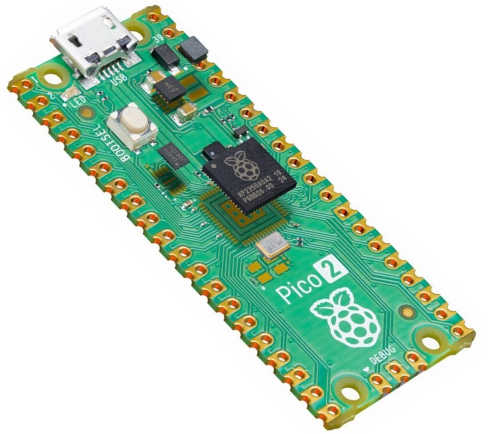| Pico 2 Faster With More Memory And RISCier |
| Written by Harry Fairhead |
| Friday, 09 August 2024 |
|
The Pi Pico 2 is the very latest from the newly "floated" Raspberry Pi Holdings plc. It has some interesting extras, but also some drawbacks - in particular no WiFi or Bluetooth initially. There are two parts to the announcement - the first is that the RP2040 chip has been upgraded to the RP2050 chip. This in turn has been used in the new design for the Pico - the Pico 2. At the moment the Pico 2 lacks WiFi. For some applications this is a deal breaker as communication isn't often optional these days. However, the Pico 2 W with WiFi should be along later in the year.
First lets get the boring bits out of the way. The Pico 2 is faster, 150MHz rather than 133MHz. It has two Cortex-M33 32-bit cores rather than two Cortex-M0s and 520KB of SRAM up from 264KB, 4MB of flash up from 2MB. Apart from these performance boosts the form factor is the same and the pinouts are the same, including the 3-pin debugging port. Some are going to bemoan the fact that the USB connector isn't USB C, but this is a development board not an iPhone and cables are the least of your worries. With regard to peripherals, the only changes are that there are now 12 PIO state machines rather than 8; 16 DMA channels rather than just 12; and the AtoD has been improved slightly. All this and the price is just $5, which is one dollar more than the original Pico. So far you mostly just get a slightly better performance for your dollar, but there is more and this part of the deal is more difficult to appraise. As well as the two ARM cores, there are also two RISC V processors and you can select which cores are active at boot time by setting bits in a register. This is going to be warmly welcomed by the RISC V enthusiasts, but to be honest it isn't going to be of great interest to most of us. When I program something like the Pico I work in C or perhaps MicroPython so the CPU that either language runs on hardly matters. All that matters is speed of execution and I think the new ARM cores are going to be faster than the RISC V cores because the ARM cores are advanced with an FPU and DSP whereas the RISC implementation is modest. It is RISC Hazard3 which has been designed by an engineer at Raspberry Pi. I guess this could be the first step towards Raspberry Pi breaking away from ARM and going its own way, which would be interesting given that ARM has invested in the company. The second big change is the introduction of security features in the form of the ARM TrustZone for Cortex-M. This takes the form of secure-signed boot, 8KB of One Time Programmable OTP memory, SHA-256 in hardware, and a hardware random number generator. To quote from the documentation: "RP2350 provides hardware and bootrom security features for three purposes: 1. Prevent unauthorised code from running on the device 2. Prevent unauthorised reading of user code and data 3. Isolate trusted and untrusted software, running concurrently on the device, from one another" The basic idea is you have to sign code using your private key and the public key is burned into the OTP and used to check that any code that is run originates from you. To stop code being read you sign the code, encrypt it and add a decryption function and sign the entire code. The decryption key is stored in the OTP and used by the decryption function. This is reasonably secure, but if you have the device and its code then it is much more vulnerable than it first seems. Exactly how secure can only be determined by how successful attacks prove to be: "Ahead of launch, we commissioned NewAE and Hextree to audit our security architecture. And now we’re offering a $10,000 bounty for the first confirmed break of our signed boot process. This will run for a month in the first instance: we may extend the window if no flaw is found, or offer further bounties for further distinct flaws." For the hobby creator all of this is fairly irrelevant as it takes quite a lot of effort to make use of it and even more to do it correctly. This is targeted at potential professional users who often have a poor view of all Raspberry Pi hardware because it is so attractive to the amateur. The Pico 2 should be ready to ship toward the end of the month and you can place pre-orders at the usual suppliers - limited to three devices per customer.
More InformationRaspberry Pi Pico 2, our new $5 microcontroller board, on sale now Related ArticlesRaspberry Pi Pico W Latest SDK + Bluetooth And Crypto The New Raspberry Pi Pico Breaks The Mold To be informed about new articles on I Programmer, sign up for our weekly newsletter, subscribe to the RSS feed and follow us on Twitter, Facebook or Linkedin.
Comments
or email your comment to: comments@i-programmer.info <ASIN:187196279X> <ASIN:1871962803> <ASIN:1871962811> |
| Last Updated ( Friday, 09 August 2024 ) |


